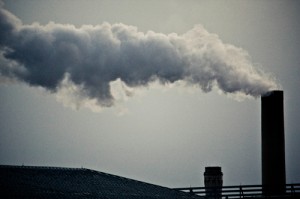EARTHTALK: Will U.S. limit its Greenhouse gas emissions?
EARTHTALK: Will U.S. limit its Greenhouse gas emissions?

Politics still stand in the way of efforts to limit U.S. greenhouse gas emissions. Two efforts, the American Clean Energy and Security Act (ACES) of 2009 and the American Power Act of 2010, got tabled or failed to make it to the Senate floor for a vote. ACES was, however, passed by a narrow margin in the House of Representatives, the first time the legislative branch has called for sweeping climate legislation. Credit: Rachel Johnson/Flickr
Dear EarthTalk: What’s the latest in regard to putting limits on greenhouse gas emissions in the U.S.? Is there any hope that Obama can get something done? – Bradley Johnson, Helena, MT
Our best hope to date was 2009’s American Clean Energy and Security Act (ACES), a bill that called for the implementation of a “cap-and-trade” system to limit carbon dioxide emissions by capping overall emissions and allowing polluters to buy or sell greenhouse gas pollution credits-similar to what the European Union has been doing since 2005 to successfully reduce its own emissions-depending upon whether they were exceeding established limits or had succeeded in coming in below them.
According to the bill, U.S. businesses needing to pollute more could buy emissions credits on the open market; those able to reduce emissions could sell their pollution credits on the same trading floor. Thus there is a built-in incentive to reduce emissions: If you exceed pollution limits you have to keep buying costly credits; and if you can get below limits you can profit from the sale of credits for the difference.
Among the bill’s key provisions was a 17 percent reduction in greenhouse gas emissions below 2005 levels by 2020, with a mid-century goal of an 80 percent reduction. Also, billions of dollars would have gone to initiatives bolstering green transportation, energy efficiency and related research and development. The bill was approved by the House in June 2009 by a narrow 219-212 vote. But Senate Democrats decided they didn’t have enough votes to get a version of the bill passed, and tabled the discussion.
While ACES may not have made it into the law books, its passage by the House was significant as it represented the first time the legislative branch called for sweeping climate legislation. Also, the bill’s provisions served as a guideline for U.S. negotiators heading to Denmark later in 2009 for the COP15 international climate talks (although in the end nothing binding was agreed upon there).
Then, in May 2010 Senators John Kerry and Joe Lieberman unveiled their own cap-and-trade climate bill for the Senate. Dubbed the American Power Act, it aimed to reduce overall U.S. greenhouse gas emissions by similar amounts as ACES. But with the nation still reeling from the effects of BP’s Gulf oil spill-the American Power Act include provisions for offshore drilling-and Senate Republicans leery of any climate legislation, the bill failed to make it to a floor vote. Some point the finger at a handful of Democratic Senators from coal-producing states for not supporting their party colleagues. Others say Obama wasn’t advocating strongly enough despite his campaign rhetoric on the topic.
“The best one could plausibly hope for in the next Congress, assuming only modest Republican gains, is some sort of weak cap on utility emissions, possibly with some weak oil saving measures, though that would still require Obama to do what he refused to do under more favorable political circumstances-push hard for a bill,” writes commentator Joe Romm of Think Progress, a liberal political blog. Romm adds that it’s inconceivable to think the next Congress would even contemplate strong climate or clean energy legislation “without Obama undergoing a major strategy change and taking a very strong leadership role in crafting the bill and lobbying for the bill and selling it to the public.”



Comments (0)